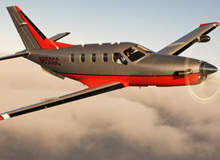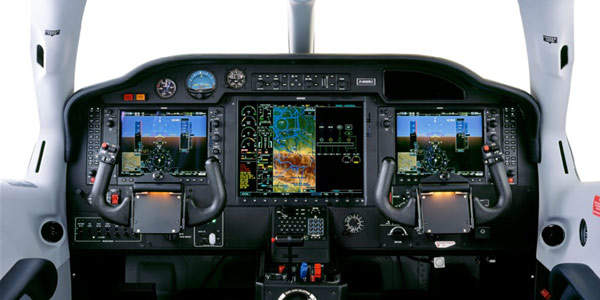Introduced in 2006, the Daher-Socata TBM 850 is an 850shp version of Daher-Socata’s six-seat TBM 700 single-engine pressurised turboprop business aircraft. With a maximum cruise speed of 320ktas, the 850 is said to be the fastest single-engine turboprop in the world.
TBM 850 development history
The initial production version, the TBM 700A, was certified in 1990 with the FAA and what is now the EASA. The 700B, which added a larger cargo door and an optional pilot entry door, was certified in 1999. Next came the 700C1, which included an unpressurised cargo compartment and new air-conditioning system, and then, in 2003, the TBM 700C2 was certified with an increased maximum take-off weight of 3,354kg, allowing an increased payload of 392kg with full fuel. This modification included a reinforced airframe and landing gear, crashworthy seats certified to 20g, a new interior and a new rear external luggage compartment.
The next variant, the 700N, became the 850, which is essentially identical to the 700C2. Up to March 2009, about 500 TBM-series aircraft had been sold, more than 200 of them the 850 version.
Its top speed of 320ktas puts it close to that of light business jets, which are more expensive to operate. Its certified ceiling is 31,000ft, it carries a maximum payload of about 650kg and it has a maximum range of 1,400nm to 1,585nm (about 1,600 to 1,800 miles). It can also land on as little as 2,100ft of airstrip.
Construction
The TBM 850 is a low-wing monoplane of aluminium and steel construction. Its airframe uses fail-safe structural design techniques such as multiple load paths and a crack-stopper band. Most of its structure is made from conventional aluminium alloys, with the wing spars, flap tracks and windshield frames machined from solid bars of aluminium. Leading edges and undercarriage doors meanwhile are made from a carbon-fibreglass composite.
The empennage, which is built partly from Nomex honeycomb, consists of a vertical stabiliser with rudder and a 6.5° dihedral horizontal stabiliser with elevator for high manoeuvrability at high and low speeds. Actuation of the 850’s control surfaces are by mechanical push/pull tubes while its landing gear is electrically controlled and hydraulically actuated.
Its dual-zone pressurisation system can maintain a 9,350ft cabin altitude at 31,000ft, and a 6,400ft cabin altitude at 25,000ft. Sea-level cabin altitude can be maintained up to 14,430ft.
The TBM 850 anti-icing system uses a combination of engine exhaust gas, an engine inertial separator, electrical windshields, electric propeller de-ice and electric stall warning heating. It has a high-speed, automatic cycling (every 67 seconds), pneumatic boot system to de-ice the leading edges of the wings and horizontal and vertical stabilisers. During night flight, a wing inspection light monitors any ice build-up.
TBM 850 flight deck and cabin
The TBM 850 comes with an avionics system that includes Honeywell’s EFIS 40 flight displays, a three-axis autopilot, colour weather radar, terrain avoidance system, in-flight traffic avoidance system (TCAS), dual GPS and an engine health / trend monitoring system, integrated into the Garmin G1000 flight deck.
In April 2009, Daher-Socata announced it had received full certification from the EASA and FAA of Garmin’s synthetic vision technology for the 850’s all-glass cockpit. The system, available as an optional upgrade for the G1000, presents 3D depictions of terrain, obstacles and traffic on the aircraft’s primary flight displays, replicating what pilots would see outside the cockpit on a clear day.
The cabin is 4.56m long, 1.22m high and 1.22m wide, and has six leather seats. The standard configuration consists of four seats and a two-piece rear bench seat (four forward and two facing aft). The seats have individual fresh-air or warm-air vents, individual reading lights, a folding executive table, 14/24V power outlets, and CD or XM satellite music or radio.
Two exterior baggage areas are provided for a total capacity of 149kg. An interior baggage area, behind the rear passenger seats, offers another 100kg.
Powerplant
The TBM 850 is powered by a Pratt & Whitney PT6A-66D turboprop, flat rated at 850shp (634kW). The 850 is limited to 700shp for take-off and landing, but in cruise flight the engine power can be increased to 850shp, which gives it its higher cruising speed than the TBM 700s, especially at high elevations. Climb rate from sea level to 31,000ft, at its maximum take-off weight, is 20 minutes.






